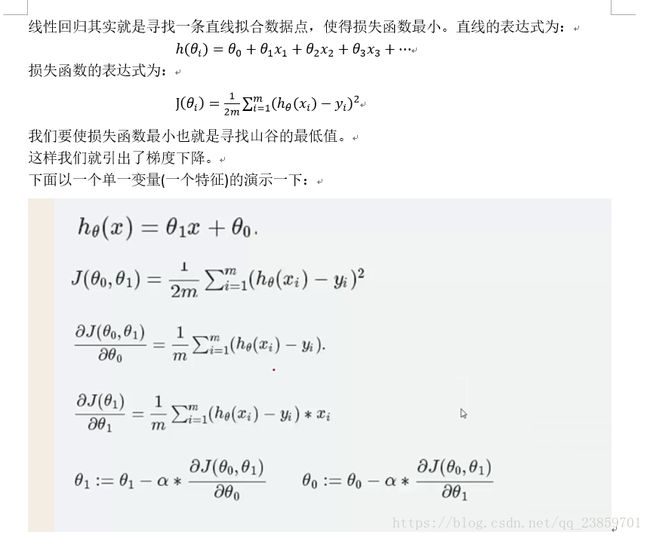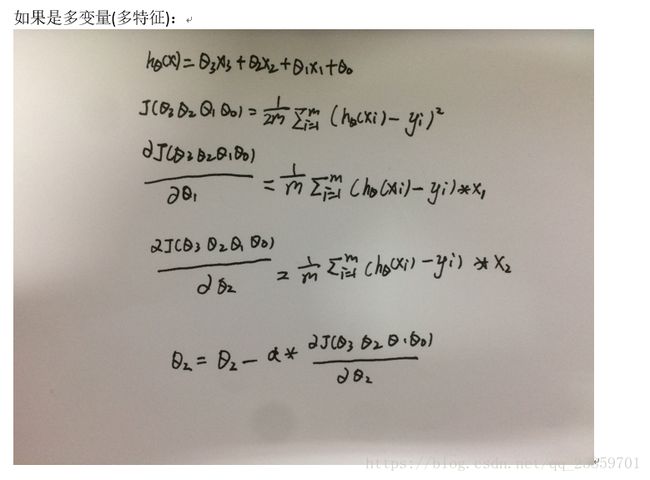python使用梯度下降算法实现一个多线性回归
图示:


import pandas as pd
import matplotlib.pylab as plt
import numpy as np
pga = pd.read_csv("D:\python3\data\Test.csv")
pga.AT = (pga.AT - pga.AT.mean()) / pga.AT.std()
pga.V = (pga.V - pga.V.mean()) / pga.V.std()
pga.AP = (pga.AP - pga.AP.mean()) / pga.AP.std()
pga.RH = (pga.RH - pga.RH.mean()) / pga.RH.std()
pga.PE = (pga.PE - pga.PE.mean()) / pga.PE.std()
def cost(theta0, theta1, theta2, theta3, theta4, x1, x2, x3, x4, y):
J = 0
m = len(x1)
for i in range(m):
h=theta0+x1[i]*theta1+x2[i]*theta2+x3[i]*theta3+x4[i]*theta4
J += (h - y[i])**2
J /= (2*m)
return J
def partial_cost_theta4(theta0,theta1,theta2,theta3,theta4,x1,x2,x3,x4,y):
h = theta0 + x1 * theta1 + x2 * theta2 + x3 * theta3 + x4 * theta4
diff = (h - y) * x4
partial = diff.sum() / (x2.shape[0])
return partial
def partial_cost_theta3(theta0,theta1,theta2,theta3,theta4,x1,x2,x3,x4,y):
h = theta0 + x1 * theta1 + x2 * theta2 + x3 * theta3 + x4 * theta4
diff = (h - y) * x3
partial = diff.sum() / (x2.shape[0])
return partial
def partial_cost_theta2(theta0,theta1,theta2,theta3,theta4,x1,x2,x3,x4,y):
h = theta0 + x1 * theta1 + x2 * theta2 + x3 * theta3 + x4 * theta4
diff = (h - y) * x2
partial = diff.sum() / (x2.shape[0])
return partial
def partial_cost_theta1(theta0,theta1,theta2,theta3,theta4,x1,x2,x3,x4,y):
h = theta0 + x1 * theta1 + x2 * theta2 + x3 * theta3 + x4 * theta4
diff = (h - y) * x1
partial = diff.sum() / (x2.shape[0])
return partial
def partial_cost_theta0(theta0, theta1, theta2, theta3, theta4, x1, x2, x3, x4, y):
h = theta0 + x1 * theta1 + x2 * theta2 + x3 * theta3 + x4 * theta4
diff = (h - y)
partial = diff.sum() / (x2.shape[0])
return partial
def gradient_descent(x1,x2,x3,x4,y, alpha=0.1, theta0=0, theta1=0,theta2=0,theta3=0,theta4=0):
max_epochs = 1000
counter = 0
c = cost(theta0, theta1, theta2, theta3, theta4, x1, x2, x3, x4, y)
costs = [c]
convergence_thres = 0.000001
cprev = c + 10
theta0s = [theta0]
theta1s = [theta1]
theta2s = [theta2]
theta3s = [theta3]
theta4s = [theta4]
while (np.abs(cprev - c) > convergence_thres) and (counter < max_epochs):
cprev = c
update0 = alpha * partial_cost_theta0(theta0, theta1, theta2, theta3, theta4, x1, x2, x3, x4, y)
update1 = alpha * partial_cost_theta1(theta0, theta1, theta2, theta3, theta4, x1, x2, x3, x4, y)
update2 = alpha * partial_cost_theta2(theta0, theta1, theta2, theta3, theta4, x1, x2, x3, x4, y)
update3 = alpha * partial_cost_theta3(theta0, theta1, theta2, theta3, theta4, x1, x2, x3, x4, y)
update4 = alpha * partial_cost_theta4(theta0, theta1, theta2, theta3, theta4, x1, x2, x3, x4, y)
theta0 -= update0
theta1 -= update1
theta2 -= update2
theta3 -= update3
theta4 -= update4
theta0s.append(theta0)
theta1s.append(theta1)
theta2s.append(theta2)
theta3s.append(theta3)
theta4s.append(theta4)
c = cost(theta0, theta1, theta2, theta3, theta4, x1, x2, x3, x4, y)
costs.append(c)
counter += 1
return {'costs':costs}
print("costs =", gradient_descent(pga.AT, pga.V,pga.AP,pga.RH,pga.PE)['costs'])
descend = gradient_descent(pga.AT, pga.V,pga.AP,pga.RH,pga.PE, alpha=.01)
plt.scatter(range(len(descend["costs"])), descend["costs"])
plt.show()
损失函数随迭代次数变换图:



